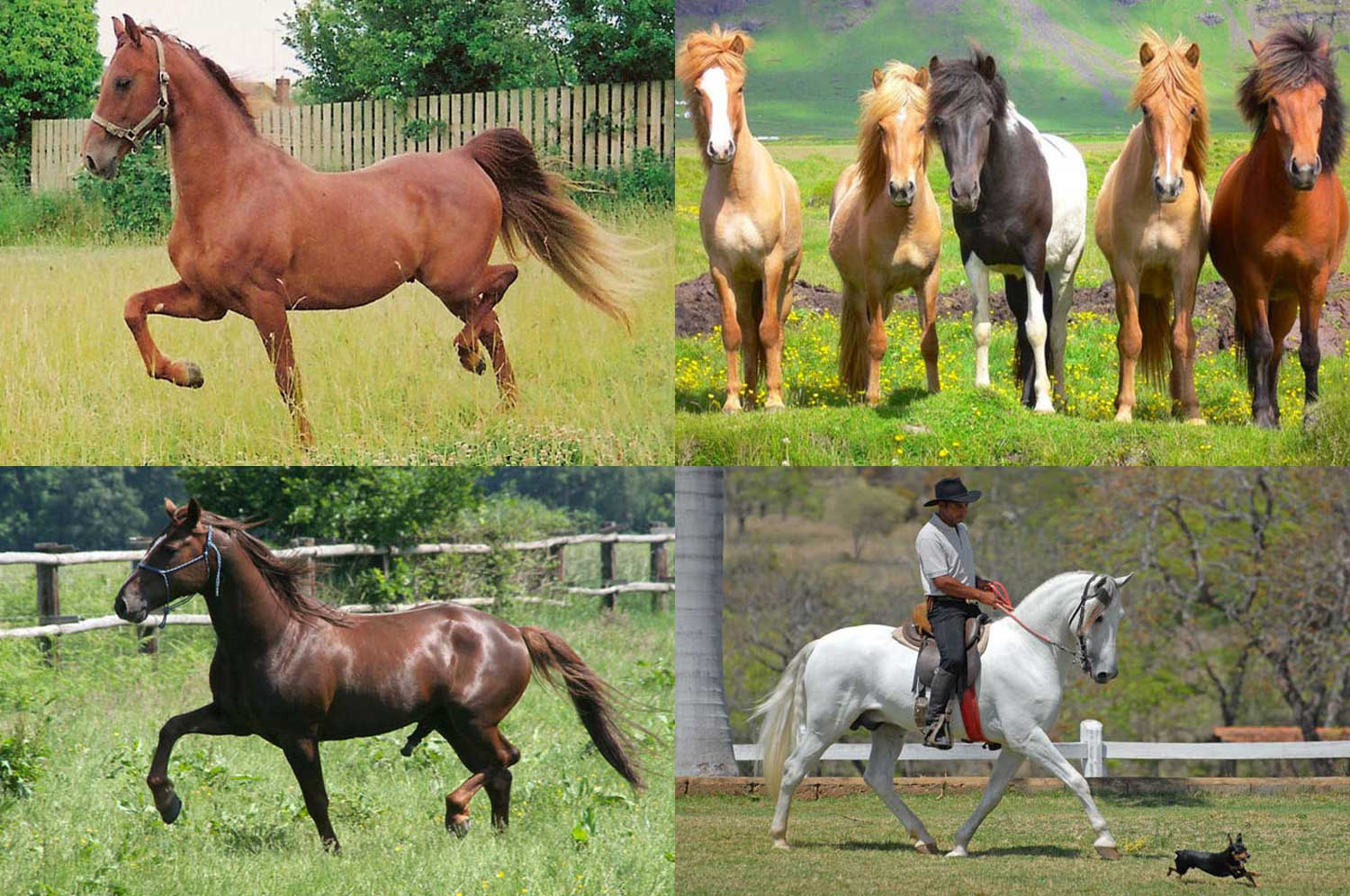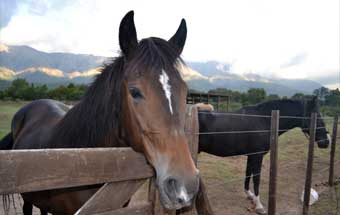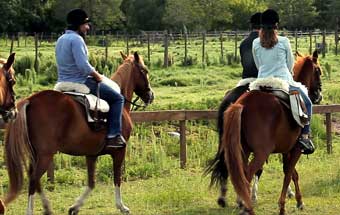Gaited Horses: Horses with a "Special Gait"
By: Nestor Imberti Posted: 24/10/2017
When we see riders in films, they usually move up and down on the back of their horses in the basic gaits, no matter if they ride romantically towards the sunset or in the prairies or escape in a wild gallop: the up and down movement is always there.
Most horse breeds only have three basic gaits, however the so called gaited horses have the ability to move in a different way.

The basic gaits of most horse breeds are the walk, the trot and the canter or gallop. Mainly in the trot, the rider bounces up and down on the horseback which causes back and hip pain after a short time.
The walk: comfortable but slow
The slowest gait of all horse breeds is the walk. The horse moves one leg at a time with the same frequency and therefore alternate between having two or three hooves on the ground.
The walk is a four-beat movement, it is slow, equal to the human pace, and very comfortable to ride.
The trot: a two-beat gait
If you speed up, your horse starts to move in the trot. In this gait, the horse lifts the diagonal leg pairs at the same time with a short moment of suspense in the air.
he trot is a two-beat gait. It is not comfortable to ride and causes pain in the riders because they bounce up and down on the horseback as the horse’s centre of gravity moves forward and up and down.
Would you like to be part of a group with an equestrian soul?
Join the Ampascachi Community. Obtain exclusive benefits for your holidays.
We tell you how to start, train and take care of your horse.
Interviews with direct providers of riding tours around the world.
Opinions of outstanding equine scientists and personalities in the equestrian sport world.
The pace and the amble – the basic gaits for all gaited horse breeds
Another two-beat gait is the pace, a slightly uneven pace is the amble. The horse moves the leg pairs of one side at the same time and then the leg pairs of the other side. The centre of gravity moves forward and left and right, the rider does not hop but rocks from side to side.
The pace is more comfortable than the diagonal trot, but not really smooth to ride. Pace and amble are the root gaits in most gaited horse breeds.
The gallop: increasing speed
Faster than the trot is the gallop. The horse lifts three limbs simultaneously, two at the front and one at the rear, then supports two limbs simultaneously, a rear and a front leg in diagonal and finally sets the third front limb back on the ground. This makes the gallop a three-beat movement.
There are also two-beat and four-beat gallops that can be trained, but sometimes they are the result of a lack of balance.
The three-beat gallop is very comfortable for the rider, but you can only ride in this fast gait for a limited amount of time as it requires a lot of energy.

Gaited Horses: smooth movements in “a special gait”
However, there are horse breeds that maintain the four-beat rhythm of the walk when they are asked to speed up and are able to reach speeds of 14 to 15 km/h. Gaited horses have this “special gait”, they do not trot and are much more comfortable to ride as the rider does not bounce up and down on the horseback.
The “paso llano” and the tölt
One example is the paso llano of the Peruvian Paso horses or the tölt of the Icelandic horses. Both are four-beat gaits although they are not the same and another difference is that the Icelandic horse also trots while the Peruvian horse does not.
In general, riding any gaited horse is very comfortable and smooth for riders.
A relief for the back of the rider
Gaited horses are a great alternative for riders who, due to back or hip problems, were forced to stop riding.
They are also ideal for those who spend long hours or ride long distances on horses.
This special gait replaces the trot, although some gaited horses are able to trot as well, they all have the walk and the gallop in common.
Subscribe to the Ampascachi Community and obtain benefits and exclusive content. Furthermore, we offer free advice on horses and equestrian tourism.
Gaited horse breeds around the world
Gaited horse breeds exist all around the world but compared to trotting horses, their number is quite low. There are differences between the breeds, but they all have in common that their special gait replaces the trot which makes riding long hours a pleasure, not a pain.
Europe is the home to breeds like the Aegidienberger, the Töltende Traber, the Arravani or the Icelandic horse. In South America we find e.g. the Mangalarga Marchador, the Paso Fino or the Peruvian Paso; the latter is the horse we breed and use for the riding holidays we offer to our guests at Ampascachi.
There are several gaited horse breeds such as the Tennessee Walker, which is the most common gaited horse, or the American Saddlebred, the oldest gaited horse breed in the United States.
A genetic mutation makes it possible
The reason for some breeds being gaited horse breeds is the fact that a genetic mutation gives them the ability to move in a special gait, as studies in Icelandic horses have shown. They found out that the mutation of the DMRT3 gene makes the difference between gaiting and non-gaiting horses.

Training improves the performance of the “special gait”
Although this special gait is inborn, it is important to train it properly. The more the horses practice, the smoother they move and long rides and trails will be very pleasant as the rider will not feel any pain in the back. Gaited horses can easily cover long distances very quickly, e. g. 30 to 40 km per day, and require less energy than other horses.
Have you ever had the pleasure of riding a gaited horse? If not, we invite you to ride on Peruvian Paso horses and make this outstanding experience.
Photo sources: [1] Paso Peruano from Ampascachi. [2] Saddlebred, wideopenpets.com. [3] Töltender Traber, fotocommunity.de. [4] Mangalarga Marchador, globetrotting.com.au.
Are you interested in knowing how to train horses?
Download our free eBook Horse training step by step. When you see how your horse learns and begins to understand your signs and aids, you will be filled with joy.
And if you want to be a professional horse trainer and get field-based training, you should check out our training program. You will have the opportunity to live in our equestrian centre and experience our full training process with young horses.
~
THIS COULD ALSO BE INTERESTING

The ideal breed for horse riding holidays
A horse for equestrian tourism must not only be suitable for trail riding tours, but also have smooth gaits and be comfortable to ride. Peruvian Paso horses meet these conditions.

Purmamarca and the Hill of Seven Colours
Purmamarca, a village in the Jujuy Province in Argentina, is situated in the foothills of the Hill of Seven Colours. This colourful mountain is part of the UNESCO World Heritage.

8 benefits of riding horses
8 physical and psychological benefits of riding: exploring mountains and valleys, observing landscapes, galopping on plains.
~
WHAT IS YOUR OPINION? LEAVE A COMMENT
Planning your horse riding holidays?
Join the Ampascachi Community. You will get exclusive advantages and guidance for your next horse riding holiday.


 German
German French
French Spanish
Spanish